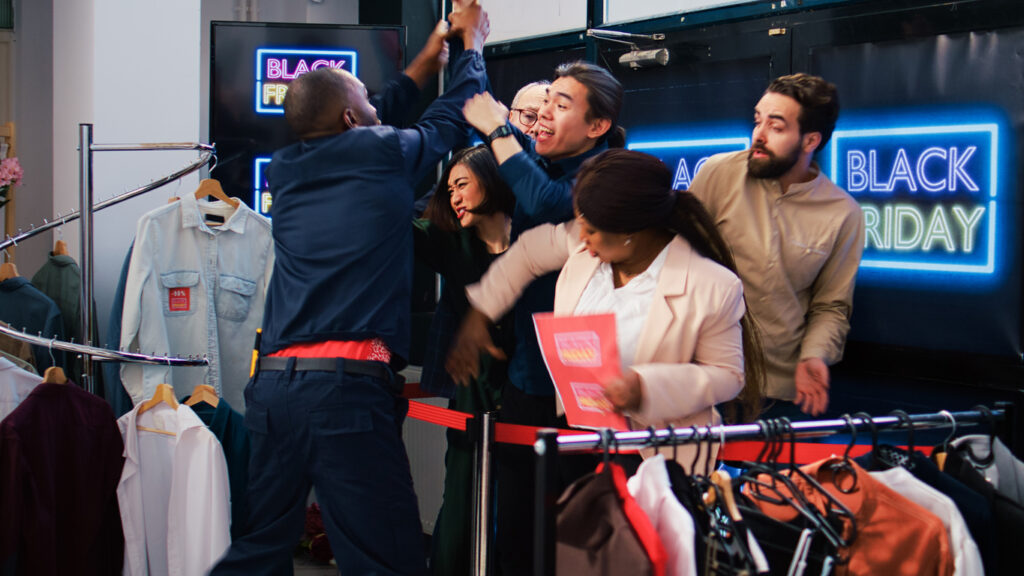

Given that it’s socially acceptable to do it in your pajamas, online shopping definitely beats the in-person version when it comes to convenience – but that doesn’t mean there won’t be throngs of people inside big box stores come the holiday shopping season.
In fact, once online-only giants like Amazon and Netflix have jumped into the physical space with their own brick and mortar stores, and even though Cyber Monday has its share of deals, Black Friday is still very much alive and well.
“The pandemic accelerated e-commerce growth, but many customers still crave physical shopping,” said Jonathan Zhang, an associate professor of marketing in the Colorado State University College of Business who has conducted research on this very topic.
Ahead of Black Friday and the holiday shopping season, Zhang sat down with SOURCE to discuss the value of physical shopping and what trends to expect from retailers working to compete in a changing market.
SOURCE: Why is Black Friday still so popular?
Black Friday has built up its own traditions and buzz over the decades as a kickoff to the holiday shopping season. The media still hypes up deals and doorbusters, and people enjoy sharing their Black Friday stories and bonding over the hunt for deals.
For some families, Black Friday shopping is an annual tradition and bonding event. Parents take kids to bond over finding deals. Millennials who grew up with Black Friday maintain the nostalgia as young adults.
The event brings the excitement and energy that online shopping lacks.
Also, many customers still prefer shopping for gifts and large purchases in physical stores, and with retailers heavily promoting doorbuster deals on items like TVs that are only available in person, this drives foot traffic and provides a thrill for deal seekers.
With that being said, stores are adapting this tradition to the changing landscape by leveraging their omni-channel capabilities where customers can order online and pickup curbside or in-store on Black Friday. This provides convenience while securing hot deals.
How do online-only companies benefit from adding physical stores?
In general, online-only companies can benefit by adding physical stores due to the following reasons:
- Customer engagement: Physical stores allow customers to actively engage with brands by providing a tangible, immersive environment. Customers can interact with products and staff in enriching ways that build stronger connections. For example, Amazon’s bookstores let customers read in a lounge area and engage with devices like Kindle and Alexa. This brings Amazon to life beyond just a transactional website.
- Brand building: Physical stores increase brand awareness and affinity. Customers view branded environments, receive personalized service and participate in events. For example, digitally native brands like Warby Parker (which is known for eyeglasses), Casper (which sells mattresses) and Glossier (a cosmetics retailer) have all opened physical showrooms to enhance their brands after starting as online-only companies.
- Market reach: Physical locations allow brands to reach customers who still prefer in-store shopping or don’t shop online. Stores give access to new demographics and markets. For example, eyewear company Warby Parker focuses stores in areas not well covered by its e-commerce channel.
- Data/feedback: Stores provide real-time feedback about what customers respond to. Salespeople learn about preferences and pain points. Companies can incorporate this data into improving products and online offerings. For example, Warby Parker iterates its eyewear designs based on in-store customer feedback.
Can a physical store boost online sales?
Physical stores can boost online sales in several ways. First, they allow customers to inspect and engage with products before making purchases online – which is especially beneficial for products like clothing furniture or electronics.
Second, physical stores build brand awareness and trust, which makes customers more comfortable buying online. Third, allowing people to buy online for in-store pickup allows customers to order online and leverage the physical store for convenience. Companies like Warby Parker, Bonobos and Nordstrom use showrooms to facilitate online purchasing.
In addition, physical stores allow customers to provide feedback and connect emotionally with the brand in a tangible way. For Netflix, physical stores could showcase the content on large TVs with theater-quality sound, allowing customers to test streaming and devices, and for the company to sell merchandise and host events.
One thing companies need to ensure they do is make sure their physical footprint aligns with their overall strategy and doesn’t become an excessive cost burden.
What shopping trends should we look for this holiday season?
A few interesting trends include the rise of mobile shopping, the ability to buy online and pick up in-store, the use of stores as mini fulfillment centers and new technologies like augmented reality to mimic physical retail experiences online.
Omni-channel personalization and understanding shopping missions will be key for retailers, and overall, physical stores will remain an open asset if leveraged properly.
They can’t just be enlarged showrooms or fulfillment venues – they need to provide personalized service and immersive brand experiences that complement the e-commerce product.
Companies also need to be flexible with their physical footprints by rightsizing and locating stores in symbiosis with online reach.
About CSU’s College of Business
The College of Business at Colorado State University is focused on using business to create a better world.
As an AACSB-accredited business school, the College is among the top five percent of business colleges worldwide, providing programs and career support services to more than 2,500 undergraduate and 1,300 graduate students. Faculty help students across our top-ranked on-campus and online programs develop the knowledge, skills and values to navigate a rapidly evolving business world and address global challenges with sustainable business solutions. Our students are known for their creativity, work ethic and resilience—resulting in an undergraduate job offer and placement rate of over 90% within 90 days of graduation.
The College’s highly ranked programs include its Online MBA, which has been ranked the No. 1 program in Colorado by U.S. News and World Report for six years running and achieved No. 16 for employability worldwide from QS Quacquarelli Symonds. The College’s Impact MBA is also ranked by Corporate Knights as a Top 20 “Better World MBA” worldwide.